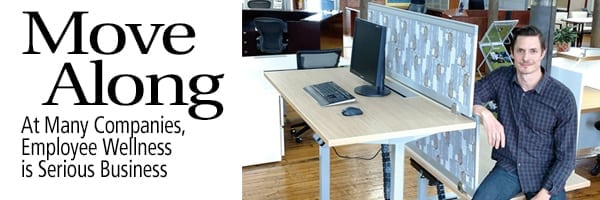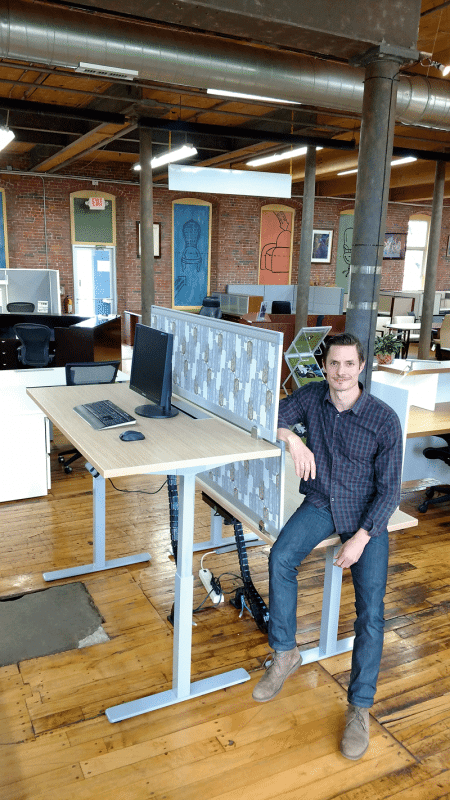
At Many Companies, Employee Wellness Is Serious Business
Move Along

Mike Morin says sales of adjustable sit-stand desks are soaring as employers discover their health and wellness benefits.
It’s no secret that workers who struggle to stay healthy and fit can cost employers in myriad ways, from absenteeism to lowered productivity. That’s why more forward-thinking companies are launching wellness initiatives aimed at boosting their staff’s health and — by extension — their morale and job satisfaction. While they can take many forms, these efforts often start with a simple goal: get moving.
Attention, desk jockeys stuck at uncomfortable workstations: Mike Morin feels your pain.
“I’ve had jobs before where you get hired, go to the office and sit down at the computer, and you realize, geez, this is not how I naturally work,” said Morin, marketing and communications coordinator at Conklin Office Furniture in Holyoke. “I’ve had that moment where you step back and realize you’ve been hunched over the desk, staring at a computer screen for two hours.”
Many employers, however, are giving desk workers some relief by installing adjustable sit-stand desks, so employees have the option of working on their feet, which can improve blood flow, reduce tiredness, and avoid the long-term drawbacks of being largely sedentary for eight hours a day.
“People are definitely more concerned about health nowadays, in general and in the workplace,” Morin said. “We offer a sit-stand, height-adjustable desk, and sales are going through the roof with those. People are spending more time at the office — not just at their workplace, but at the home office as well. And they want desks they can stand at.”
One selling point, he said, is giving employees a choice, convincing employers they don’t have to go with a one-size-fits-all mentality. Sit-stand desks can often be incorporated right alongside traditional desks and tables, and can be designed to match the existing décor and furniture in the office.

Lisa Bowler says Baystate takes a holistic approach to employee wellness, as reflected by its wide range of programs to that end.
It’s one way employers are taking a harder look at workplace wellness, incorporating not just equipment, but programs and incentives to keep their workers healthy, reduce absenteeism, and, in theory, lower costs in the long term.
Lisa Bowler, manager of Wellness and WorkLife at Baystate Health, says her employer has offered a raft of wellness benefits for many years, and sit-stand desks are an option many workers have chosen — but emphasized that they’re a very small part of the equation in a system where 60% of employees are clinical staff who are on their feet all day, not behind desks.
“It’s such a vast array of roles and types of jobs … the challenge is, how do we deliver wellness programs that make the most sense?” Bowler noted. “We offer a whole host of programs — a great variety — and we provide those resources to support our employees’ health and well-being because we know, in many ways, that contributes to a healthy organizational culture and also makes for a great place to work.”
Lisa Verville would agree. As Human Resources director for the O’Connell Companies in Holyoke, she has overseen a formal wellness committee launched two years ago that partners with Blue Cross Blue Shield (BCBS) to offer wellness-related apps, challenges, and incentive progams where not only employees, but their spouses can earn money for reaching activity and fitness goals. Employees are also reimbursed up to 75% for annual gym memberships.
“The O’Connell Companies have always had a culture of caring about their employees,” Verville said. “This is another facet of that — making employees aware of things they can do and listening to what they want, and trying to provide resources that make the healthy choice the easy choice.”
Culture of Health
Mary Ellen Shea, Marketing manager at O’Connell, told BusinessWest that wellness efforts at the firm stretch back well before the formal committee. “There’s always been a culture of health,” she said, “but now I feel it’s been ramped up.”
SEE: List of Office Furniture Dealers in the Area
Employees earn points through the BCBS partnership for walking, hydration, and nutrition challenges, as well as completing online workshops, scheduling wellness visits, and other tasks.
“It encourages a holistic approach,” Verville said, noting that employees were surveyed on the types of programs they wanted to see. “It’s actually been a lot of fun. We also had our health fair last November, and it was fun to see people from all our companies get together. We provided incentives — gift cards, gift baskets — to get people to come, and we had a great turnout, and got a lot of good feedback; we’re looking forward to doing it again this year, with hopefully an even bigger event.”
While many employees try to participate in many wellness activities, one challenge for O’Connell is that it’s a geographically dispersed company, with several affiliate companies spread across the Valley. “So it’s hard to get everyone to participate in a lunch and learn, with so many employees out in the field,” she went on. “But the committee has representatives from every subsidiary, we get direct feedback on what works and what doesn’t work. Not every program is tailored to the same group; we try to offer a lot of variety while still focusing on what the needs and interests are.”
This fall, it will be easier to bring employees together for wellness activities when O’Connell moves into a newly built headquarters on Kelly Way in Holyoke, consolidating more of its operations under one roof. The project allows the company to incorporate wellness initiatives right into the building design.
“We have a great opportunity there,” Verville said. “When we move, the plan is to install, for those who want them, the adjustable workstations. We’re also thinking about walking paths and things of that nature, a fitness room with equipment in it, and there will be an area dedicated to the wellness seminars.
“It’ll bring more people together,” she went on. “The new building will provide a lot of new opportunities, and having more employees in one location will help encourage more collaboration and cohesiveness, and get more people involved.”
Bowler said Baystate has built a similar emphasis on wellness into its operations, which are even more spread out than O’Connell’s.

Lisa Verville says employees at the O’Connell Companies have taken enthusiastically to the wellness programs launched two years ago.
“We would define a culture of health as a work environment where our employees have the resources and tools and support that empowers them and motivates them to take steps to benefit their health,” she said. “We’ve evolved the program over the years, and we think it’s important to view health holistically. Programs are designed in such a way to help our team members learn how to make healthy lifestyle choices and help them manage their responsibilities at work and at home.”
The effort includes access to a WebMD portal that provides not only health information but access to fitness challenges. In addition, “we have walking clubs, mindfulness classes, two or three educational webinars each month, confidential counseling for employees and family members, Weight Watchers memberships free of charge, and a whole host of resources for parents,” Bowler said, not to mention smoke-free facilities since 2007.
Rising Tide
Many of the initiatives at Baystate and O’Connell mesh with the top workplace-wellness trends recently outlined by the Corporate Health & Wellness Assoc. These include:
• Lifestyle management, which may include cholesterol screenings, flu shots, sleep-management programs, and incentives (like gift cards or insurance-premium discounts) for participating in corporate wellness programs;
• Weight-loss programs, from yoga and Zumba classes on site to gym and Weight Watchers memberships, to offering healthy sbacks in the office;
• Redesigned workspaces, which include standing or treadmill desks, ergonomic chairs and headsets, and FitBit trainers and pedometers;
• Smoking bans in the office and accompanying smoking-cessation programs to help employees kick the habit for good; and
• Stress-management programs, including meditation instruction and guidance in everything from personal finance to parenting.
And programs don’t have to be tied to specific company initiatives, Shea said. “Usually twice a day, team members or employees meet in the lobby, go out, and walk together around the block.”
She and Verville said wellness programs conceivably lower costs for companies by reducing absenteeism — or presenteeism, where tired or ailing employees show up but are far from productive.
“We certainly have seen that,” Bowler added, noting that Baystate has won recognition from national business groups for its wellness policies. “Employees who regularly participate are more engaged, healthier, and more productive. Beyond that, having these programs available is the right thing to do. As an organization, we’ve taken the view that achieving a culture of health is not something that occurs overnight. We are in this for the long term and are committed to it.”
From talking to Conklin’s clients, Morin can tell interest is rising.
“Nowadays, people are obsessed with health, and for good reasons,” he said. “People are paying more attention to what they’re eating, so it’s natural they’re noticing how much time they’re sitting at a desk each day. Studies have come out claiming that sitting down for long periods of time is as unhealthy as smoking.”
That’s why he’s gratified that employers are increasingly tailoring office design to individual worker needs through flexible workstations. “In the past, offices were set up a certain way, but not everyone works like that. There’s a new focus in ergonomics where it’s more customizable.”
Bowler said companies of any size can make changes to improve employees’ health, and some — from walking clubs to lunch-and-learn sessions — don’t take much financial investment. “But to really get that return and change the culture, there needs to be a comprehensive approach.”
And it’s happening more and more, she told BusinessWest. “The concept of worker wellness has been around a long time. It just seems to be gaining more energy and visibility the last several years.”
And it can begin with something as simple as standing up.
Joseph Bednar can be reached at [email protected]




